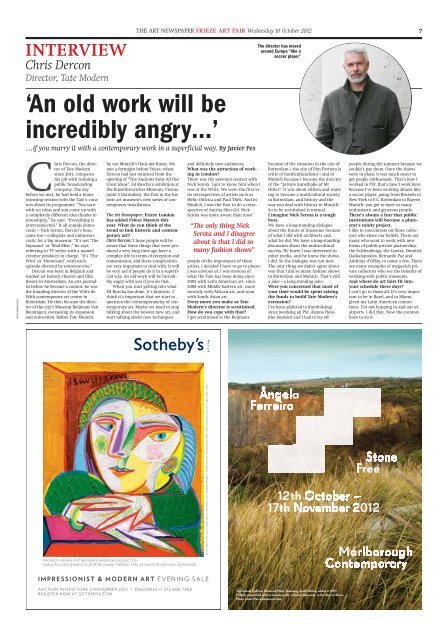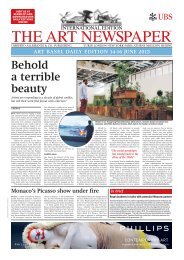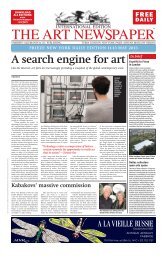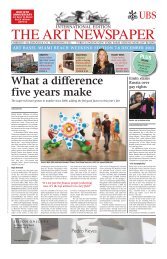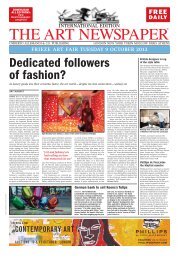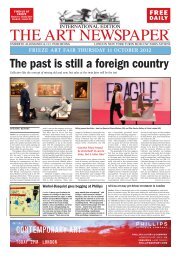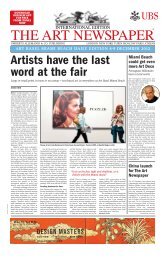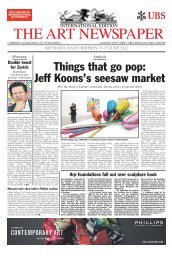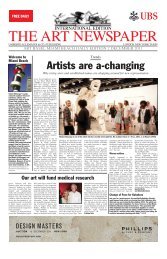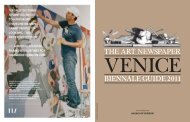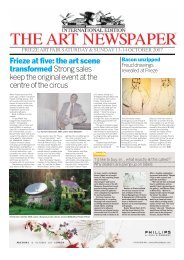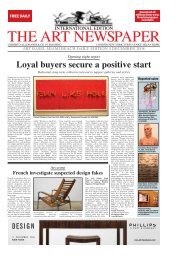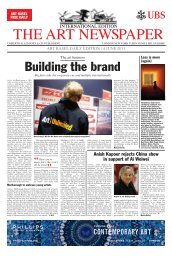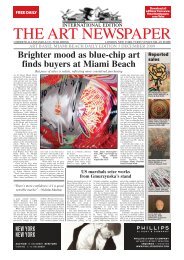Issue 2 - The Art Newspaper
Issue 2 - The Art Newspaper
Issue 2 - The Art Newspaper
Create successful ePaper yourself
Turn your PDF publications into a flip-book with our unique Google optimized e-Paper software.
PHOTO: MARION VOGEL<br />
INTERVIEW<br />
Chris Dercon<br />
Director, Tate Modern<br />
Chris Dercon, the director<br />
of Tate Modern<br />
since 2011, compares<br />
his job with running a<br />
public broadcasting<br />
company. <strong>The</strong> day<br />
before we met, he had held a brainstorming<br />
session with the Tate’s curators<br />
about its programme. “You start<br />
with set ideas and you come up with<br />
a completely different idea thanks to<br />
serendipity,” he says. “Everything is<br />
interconnected.” It all sounds democratic—Nick<br />
Serota, Dercon’s boss,<br />
came too—collegiate and unbureaucratic<br />
for a big museum. “It’s not ‘<strong>The</strong><br />
Sopranos’ or ‘Mad Men’,” he says,<br />
referring to TV series with a named<br />
creative producer in charge. “It’s ‘<strong>The</strong><br />
Wire’ or ‘Homeland’, with each<br />
episode directed by someone else.”<br />
Dercon was born in Belgium and<br />
studied art history, theatre and film<br />
theory in Amsterdam. An arts journalist<br />
before he became a curator, he was<br />
the founding director of the Witte de<br />
With contemporary art centre in<br />
Rotterdam. He then became the director<br />
of the city’s Museum Boijmans Van<br />
Beuningen, overseeing its expansion<br />
and renovation. Before Tate Modern,<br />
THE ART NEWSPAPER FRIEZE ART FAIR Wednesday 10 October 2012 7<br />
‘An old work will be<br />
incredibly angry…’<br />
…if you marry it with a contemporary work in a superficial way. By Javier Pes<br />
he ran Munich’s Haus der Kunst. We<br />
met a fortnight before Frieze, when<br />
Dercon had just returned from the<br />
opening of “<strong>The</strong> Ancients Stole All Our<br />
Great Ideas”, Ed Ruscha’s exhibition at<br />
the Kunsthistoriches Museum, Vienna<br />
(until 2 December), the first in the historic<br />
art museum’s new series of contemporary<br />
installations.<br />
<strong>The</strong> <strong>Art</strong> <strong>Newspaper</strong>: Frieze London<br />
has added Frieze Masters this<br />
year. What do you think of the<br />
trend to link historic and contemporary<br />
art?<br />
Chris Dercon: I hope people will be<br />
aware that these things that were produced<br />
a very long time ago have a<br />
complex life in terms of reception and<br />
transmission, and these complexities<br />
are very important to deal with. It will<br />
be very sad if people do it in a superficial<br />
way. An old work will be incredibly<br />
angry with you if you do that.<br />
When you start getting into what<br />
Ed Ruscha has done, it’s fantastic. I<br />
think it’s important that we start to<br />
question the contemporaneity of contemporary<br />
art. Maybe we need to stop<br />
talking about the newest new art, and<br />
start talking about new techniques<br />
PROPERTY FROM A DISTINGUISHED AMERICAN COLLECTION<br />
PABLO PICASSO FEMME À LA FENÊTRE (MARIE-THÉRÈSE), 1936. ESTIMATE $15,000,000-20,000,000<br />
IMPRESSIONIST & MODERN ART EVENING SALE<br />
AUCTION IN NEW YORK 5 NOVEMBER 2012 | ENQUIRIES +1 212 606 7360<br />
REGISTER NOW AT SOTHEBYS.COM<br />
and definitely new audiences.<br />
What was the attraction of working<br />
in London?<br />
<strong>The</strong>re was the personal contact with<br />
Nick Serota. I got to know him when I<br />
was at the Witte. We were the first to<br />
do retrospectives of artists such as<br />
Hélio Oiticica and Paul <strong>The</strong>k. And in<br />
Munich, I was the first to do a retrospective<br />
of Amrita Sher-Gil. Nick<br />
Serota was more aware than most<br />
“<strong>The</strong> only thing Nick<br />
Serota and I disagree<br />
about is that I did so<br />
many fashion shows”<br />
people of the importance of these<br />
artists. I decided I have to go to places<br />
I was envious of. I was envious of<br />
what the Tate has been doing since<br />
2003 with Latin American art, since<br />
2008 with Middle Eastern art, more<br />
recently with African art, and soon<br />
with South Asian art.<br />
Every move you make as Tate<br />
Modern’s director is scrutinised.<br />
How do you cope with that?<br />
I got scrutinised at the Boijmans<br />
© SOTHEBY’S, INC. 2012 TOBIAS MEYER, PRINCIPAL AUCTIONEER, #9588677 © 2012 ESTATE OF PABLO PICASSO / ARTISTS RIGHTS SOCIETY (ARS), NEW YORK<br />
<strong>The</strong> director has moved<br />
around Europe “like a<br />
soccer player”<br />
because of the situation in the city of<br />
Rotterdam—the city of Pim Fortuyn [a<br />
critic of multiculturalism]—and in<br />
Munich because I became the director<br />
of the “private kunsthalle of Mr<br />
Hitler”. It was about elitism and wanting<br />
to become a multicultural society<br />
in Rotterdam, and history and the<br />
way you deal with history in Munich.<br />
So to be scrutinised is normal.<br />
I imagine Nick Serota is a tough<br />
boss.<br />
We have a long-standing dialogue<br />
about the future of museums because<br />
of what I did with architects and<br />
what he did. We have a long-standing<br />
discussion about the multicultural<br />
society. He knew I was interested in<br />
other media, and he knew the shows<br />
I did. So the dialogue was not new.<br />
<strong>The</strong> only thing we didn’t agree about<br />
was that I did so many fashion shows<br />
in Rotterdam and Munich. That’s still<br />
a joke—a long-standing joke.<br />
Were you concerned that most of<br />
your time would be spent raising<br />
the funds to build Tate Modern’s<br />
extension?<br />
I’ve been addicted to [fundraising]<br />
since [working at] PS1. Alanna Heiss<br />
[the founder] and I had to lay off<br />
<strong>The</strong> hole at Cullinan Diamond Mine, Gauteng, South Africa, where in 1905<br />
F. Wells unearthed what is known as the Cullinan Diamond, or the Star of Africa.<br />
Photo credit: Petra Diamonds Ltd.<br />
people during the summer because we<br />
couldn’t pay them. Once the shows<br />
were in place, it was much easier to<br />
get people enthusiastic. That’s how I<br />
worked in PS1; that’s how I work here.<br />
Because I’ve been working almost like<br />
a soccer player, going from Brussels to<br />
New York to F.C. Rotterdam to Bayern<br />
Munich, you get to meet so many<br />
enthusiastic and generous people.<br />
<strong>The</strong>re’s always a fear that public<br />
institutions will become a plutocrat’s<br />
vanity project.<br />
I like to concentrate on those collectors<br />
who share our beliefs. <strong>The</strong>re are<br />
many who want to work with new<br />
forms of public-private partnership:<br />
the Falckenbergs, the Goetzs, Dimitris<br />
Daskalopoulos, Bernardo Paz and<br />
Anthony d’Offay, to name a few. <strong>The</strong>re<br />
are many examples of mega-rich private<br />
collectors who see the benefits of<br />
working with public museums.<br />
And where do art fairs fit into<br />
your schedule these days?<br />
I can’t go to them all. It’s very important<br />
to be in Basel, and in Miami,<br />
given my Latin American connections.<br />
I’m not hopping in and out of<br />
airports. I did that. Now the curators<br />
have to do it.


